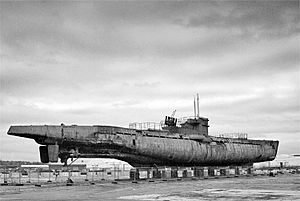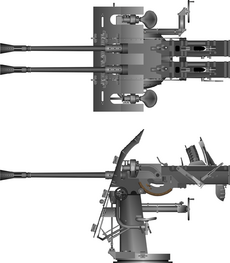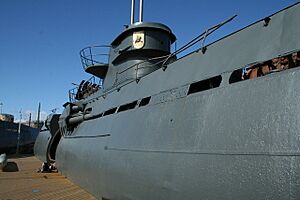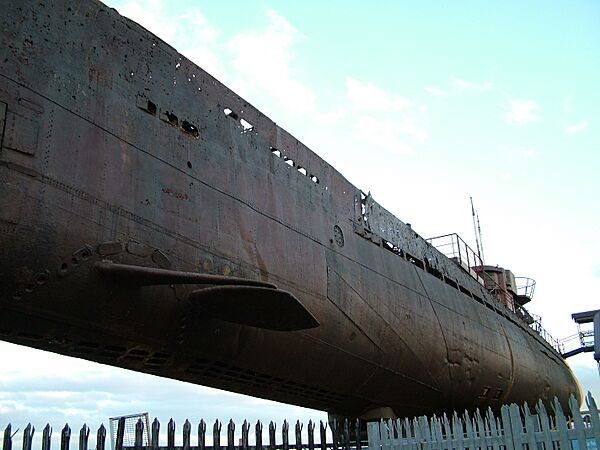German submarine U-534 facts for kids

U-534 at Birkenhead Docks in March 2007
|
|
Quick facts for kids History |
|
|---|---|
| Name | U-534 |
| Ordered | 10 April 1941 |
| Builder | Deutsche Werft AG, Hamburg |
| Yard number | 352 |
| Laid down | 20 February 1942 |
| Launched | 23 September 1942 |
| Commissioned | 23 December 1942 |
| Fate |
|
| General characteristics | |
| Class and type | Type IXC/40 submarine |
| Displacement | |
| Length |
|
| Beam |
|
| Height | 9.60 m (31 ft 6 in) |
| Draught | 4.67 m (15 ft 4 in) |
| Installed power |
|
| Propulsion |
|
| Speed |
|
| Range |
|
| Test depth | 230 m (750 ft) |
| Complement | 4 officers, 44 enlisted |
| Armament |
|
| Service record | |
| Part of: |
|
| Identification codes: | M 49 357 |
| Commanders: |
|
| Operations: |
|
| Victories: |
|
The German submarine U-534 was a special kind of submarine called a Type IXC/40 U-boat. It was built for the German navy (called the Kriegsmarine) during World War II. This submarine was made in 1942 in Hamburg, Germany.
U-534 is one of only four German World War II submarines that are still around today. The others are U-505 in Chicago, U-995 in Germany, and U-2540 in Bremerhaven. U-534 is unique because it has been cut into sections for display.
This submarine was mostly used for training its crew. It never sank any enemy ships during the war. On May 5, 1945, a British Royal Air Force plane sank U-534 near a Danish island. In 1993, the submarine was brought up from the seabed. It is now a Museum ship in Birkenhead, England, where visitors can learn about its history. In 2021, a group called Big Heritage took over its care.
Contents
About U-534
Submarines like U-534 were designed to travel underwater. They were larger than some other German submarines of the time. When U-534 was on the surface, it weighed about 1,144 tons. Underwater, it weighed a bit more, around 1,257 tons.
This U-boat was about 76.76 meters (251 feet) long. That's longer than two basketball courts! It was 9.60 meters (31 feet) tall and could go as deep as 230 meters (754 feet) underwater.
How U-534 Was Built
U-534 had two powerful diesel engines for moving on the surface. These engines produced a lot of power, about 4,400 horsepower. When it was underwater, it used two electric motors, which gave it about 1,000 horsepower.
On the surface, the submarine could travel at a top speed of 18.3 knots (about 34 kilometers per hour). Underwater, it was slower, reaching about 7.3 knots (13.5 kilometers per hour). It could travel a very long distance on the surface, over 13,850 nautical miles (25,650 kilometers). Underwater, its range was much shorter, about 63 nautical miles (117 kilometers).
What Made U-534 Special
U-534 carried several weapons. It had six torpedo tubes, which are like launchers for torpedoes. Four were at the front and two at the back. It could carry 22 torpedoes in total.
It also had a large deck gun, a 10.5 cm (4.1 inch) naval gun, for fighting on the surface. For protection against aircraft, it had anti-aircraft (AA) guns. These included a 3.7 cm (1.5 inch) AA gun and a twin 2 cm (0.79 inch) AA gun. The submarine had a crew of 48 people.
Torpedoes: Underwater Weapons
U-534 was special because it carried a type of electric torpedo called the G7es (TXI), also known as Zaunkönig II. This was an improved version of an older torpedo. It could travel about 5,700 meters (6,200 yards) at 24 knots (44 km/h).
These torpedoes were designed to find their target by listening for sounds, a method called passive homing. They were created to fight against a British countermeasure called Foxer. When U-534 was salvaged, at least three of these special TXI torpedoes were found.
Anti-Aircraft Guns: Protecting from Above
U-534 had a rare twin 3.7 cm Flakzwilling M43U anti-aircraft gun. This was one of the best AA weapons used by the German navy. It was usually found on larger submarines like the Type IX because it was quite heavy. This gun helped protect the submarine from enemy planes.
Tricky Defenses: Avoiding Enemy Sonar
Just above the propeller on the right side of U-534 was a special chute. This chute could launch a decoy called Bold. A decoy is something used to trick an enemy. The Bold decoy created a screen of bubbles in the water. This made a false target for enemy sonar, making it harder for them to find the submarine.
U-534's Journey: Training and Patrols
After it was built, U-534 spent time training its crew and testing its weapons. This happened from December 1942 to May 1943. Later, its main gun was removed, and more anti-aircraft guns were added.
First Missions and Challenges
In May 1944, U-534 began its first real mission. It went to the waters off Greenland to report on the weather. This first trip had problems, including an oil leak and bad weather in the North Atlantic Ocean.
On August 11, 1944, a plane attacked the submarine, but it wasn't damaged. A few days later, two British Halifax bombers attacked U-534 and two other U-boats. The U-boat's guns fired back, damaging the planes. U-534 then safely reached Bordeaux, France, where it got a new device called a Schnorchel. This device allowed the submarine to run its diesel engines and get fresh air while still underwater.
Escaping Danger and Repairs
On its second mission, starting in August 1944, U-534 had to escape from Allied forces in France. When the crew first used the new Schnorchel, exhaust gases leaked into the submarine, and some crew members fainted. When they surfaced for air, a British Wellington bomber spotted and attacked them. The U-boat's gunners shot down this plane.
U-534 eventually made it to Kiel, Germany, in October 1944. It then went through a big repair and upgrade in Stettin, which kept it out of action until May 1945.
The Final Battle: Sinking of U-534
In the early morning of May 5, 1945, German forces in some areas, including Denmark, were ordered to surrender. U-534 was told that the fighting had stopped south of a certain line. However, the submarine was north of this line.
The commander, Nollau, decided to travel north on the surface with two other U-boats. They were in a shallow part of the Kattegat Sea, where it was too shallow to dive quickly. Two British RAF Liberator planes attacked them. The crew of U-534 managed to shoot down one of the bombers.
However, a depth charge from one of the planes hit U-534. A depth charge is a bomb designed to explode underwater. The submarine was badly damaged at the back and started to fill with water. It sank northeast of Anholt island. The British plane that was shot down also crashed, and everyone on board was lost.
There were 52 men on U-534. All of them managed to get out of the sinking submarine, and 49 survived. Five men were stuck in the torpedo room as the submarine went down. They used their training to escape through the front torpedo hatch once the U-boat was resting on the seabed, about 67 meters (220 feet) deep. They swam to the surface. Sadly, one 17-year-old radio operator, Josef Neudorfer, died from lung damage because he didn't breathe out while swimming up. Two other crew members died from the cold water.
Finding U-534 Again
U-534 stayed on the seabed for almost 41 years. In 1986, a Danish wreck hunter named Aage Jensen found it. There were rumors that the U-boat might contain "Nazi gold," which created a lot of excitement. A Danish millionaire, Karsten Ree, helped pay to raise the submarine. However, when it was brought up, nothing unusual was found inside.
The Dutch company Smit Tak raised U-534 from the sea on August 23, 1993. Inside the submarine, they found old phonograph records. After being carefully preserved, these records could still be played! They contained music by famous composers like Johann Sebastian Bach and Robert Schumann, as well as singers like Zarah Leander.
U-534 as a Museum Ship
In 1996, U-534 was moved to Birkenhead, England. It was part of a museum collection for several years. In 2007, the local transport authority, Merseytravel, bought the submarine to display it at the Woodside Ferry Terminal.
To make it easier and cheaper to move and display, the submarine was cut into five large sections. Two of these sections were later joined back together. Now, visitors can see the submarine in these cut sections. This allows people to look inside and understand how it worked without actually having to go inside the U-boat itself. Engineers spent a month cutting the submarine apart in early 2008. Each section weighed up to 240 tons and was moved by a special floating crane.
The "U-boat Story" exhibition opened on February 10, 2009, and was open until 2020. On October 24, 2021, it was announced that the charity Big Heritage, which runs the Western Approaches Museum in Liverpool, would take care of U-534. They plan to build a new visitor center for it by 2026.
Gallery
-
Part of the hull and conning tower of U-534
See also
Surviving U-boats
- SM U-1
- U-505
- U-995
- Wilhelm Bauer (originally U-2540)
Other









